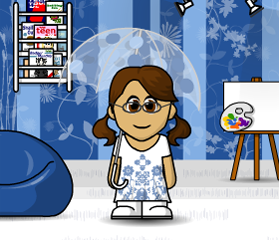
Are you ready to let your creative streak run free? Animated avatars that you can create with CrazyTalk Messenger take image interactivity to the next level. CrazyTalk comes in two versions: a free version called CrazyTalk for Skype (go to www.reallusion.com/crazytalk4skype) and a paid version called CrazyTalk Messenger (go to www.reallusion.com/crazytalk). The free version comes with a fixed selection of avatars that you can use but can’t modify. CrazyTalk Messenger allows you to design and build avatars that you also can use in Skype. You can use photos of yourself. And by the way, having a photorealistic avatar of yourself on Skype may be the perfect solution for when you’re having a bad hair day!
What do you want to make your animated avatar do? Maybe you want your character’s mouth to lip-synch with yours as you speak on Skype, or perhaps you’d like it to capture a mood to suit the occasion. Building avatars with CrazyTalk Messenger is surprisingly easy. We don’t have the space here to step you through all the features of CrazyTalk, but we can tell you enough to whet your appetite. The first step is to import an image of the character you want to work with. The image can be a photo, a cartoon, or a scan of a portrait, for example. As long as it is a standard graphic such as a JPG file, that’s fine. You can find some free and mostly copyright-friendly images at the following sites:
http://www.pics4learning.com
http://www.freephotos.se
http://en.wikipedia.org/wiki/Public_domain_image_resources
The best topics to search for are animals, portraits, and cartoons. Although you can find a wealth of images to choose from, be aware that some images may have copyright notices and usage restrictions.
To import a picture into CrazyTalk, follow these steps:
- Click the top icon on the vertical toolbar on the left side of the Model Page. The Open File window opens, enabling you to browse for image files on your hard drive. (Incidentally, CrazyTalk supports directly importing an image of a printed photo from a scanner attached to your computer.)
- Navigate to the JPEG or BMP image file you want to import, click it, and then click the Open button.
There’s more to animating an avatar than just importing a picture. When the avatar’s jaws move in sync with your speech and its eyes blink, you want it to appear natural. You also need to draw some simple contour lines so that CrazyTalk knows how to smoothly morph the avatar’s face when it is speaking or moving its head slightly.
After you import the picture, you can rotate the image so that the avatar’s face is upright and vertical. If the face is slanted, the jaws can’t move naturally. To fix the image, identify the spindle points for the lips and eyes, as follows:
- Click the Auto-Fit Anchor Points toolbar icon (the fourth icon in the vertical toolbar at the left). The Auto-Fit Anchor Points window opens.
- Drag the points over your imported image to match the reference image on the right; then, click the OK button.
CrazyTalk processes the image and generates a set of contour lines. After the image is processed, you can adjust the main contour lines for the eyebrows, eyes, nose, mouth, and face mask. CrazyTalk uses the position of these points to “morph” the picture to match your speech in Skype. You can test your avatar by having it speak. Click the triangular Play button to start a prerecorded audio announcement. There are also pause, stop, and volume controls.
As you hear the message played, the avatar’s mouth, eyes, and face move in sync with the audio message.
You can tweak the position of the spindle points and contour lines to get a fairly convincing animated avatar.
Click the Advanced Facial Settings button to access features that can help you deal with a variety of challenges. Say, for example, that you wanted to make the Mona Lisa into an avatar. Without some modification, you might find that making her image “speak” replaced that indelible smile with —gasp! — a need for dentures! Fortunately, CrazyTalk comes equipped with a set of virtual dentures and even a collection of eyes.
Some of the CrazyTalk facial settings include:
- Adjustments to the eyes, teeth, and mouth: You can adjust the lighting levels inside the mouth, or even adjust ends of the lips to give the appearance of a smile or a frown.
- Head motion: You can set the head motion to match the energy of your character.
- Facial formatting: A nice finishing touch of this software is that you can have the mouth automatically close when the avatar stops speaking. CrazyTalk Messenger makes it easy to create, test, and customize your avatar. After the avatar is created with Messenger, you can run it in Skype using another software product, CrazyTalk for Skype Video Lite, which is available as a free download (go to https://share.skype.com/ directory/crazytalk_for_skype_video_lite/view and click the Download Now link).
The Video Lite program connects your CrazyTalk avatar to Skype. CrazyTalk uses the video channel in Skype to broadcast your avatar as though you had a webcam.
To enliven your avatar, you can use a behavior panel with special kinds of emotion smileys. Despite the term smiley, you can click these images to show your avatar laughing, crying, frowning, and looking surprised, among other expressions.

